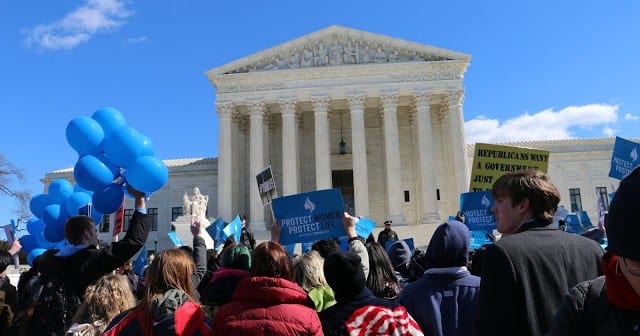John Seago, Legislative Director for Texas Right to Life, attended the oral arguments before the Supreme Court in Whole Women’s Health v. Hellerstedt on Wednesday morning. He explains the stark contrast visible at the Court.
The Texas Right to Life team was out in force this week in Washington, D.C., for the historic hearing on the case challenging provisions of a Pro-Life Texas law. For the first time in almost a decade, the Supreme Court of the United States heard oral arguments in a challenge to Pro-Life legislation. The High Court is set to decide whether House Bill 2, the Pro-Life Omnibus Bill the Texas Legislature passed in 2013, is constitutional and can be fully enforced in Texas.
The cultural divide between abortion activists and Pro-Life advocates was evident in the stark contrast displayed on the steps of the Supreme Court. A crowd of about 2,000 gathered and engaged in rancorous shouting, chants, and cheers. Texas Right to Life joined many other Pro-Life groups for a peaceful rally. Texas Right to Life’s Melissa Conway offered words of encouragement and unity over the jeers and chants of abortion activists. Speakers were forced to contend with the interrupting outbursts and chaotic shouting of our opponents.
A deep divide was undeniable inside the Supreme Court as well. Very early in the 80 minute-long arguments, two opposing groups of Justices were evident. The two groups attempted to examine the case from very different perspectives. On one side, Justices Breyer, Ginsburg, Kagan, and Sotomayor tried to redefine the role of the Supreme Court as the authority that can overrule a state legislature if they believe the state has made a medically imprudent decision. On the other side, Justices Alito, Roberts, and most likely Thomas (he characteristically did not speak during the arguments) tried to remain within the boundaries of previous court precedent and limit the role of the Supreme Court to determining whether the Texas law is a rational means of furthering a legitimate state interest.
Accordingly, the four liberal Justices enthusiastically attempted to focus the hearing on the medical evidence and arguments to assert that Texas should not have passed House Bill 2. Ginsburg and Sotomayor insisted that the legislature was foolish in passing House Bill 2, emphasizing data provided by the plaintiffs and arguing that complications from elective abortions are less common than complications and injuries from other procedures. Several times, they implied that if the Texas Legislature really did want to protect their citizens they would raise health and safety standards for other medical procedures. In response, Texas Solicitor General Scott Keller, who defended the law, noted that the Court ruled in Gonzales v. Carhart that state legislatures have the competency to legislate when there is medical uncertainty because of differing medical opinions on a topic.
The position advanced by the liberal Justices is a drastic shift from how the High Court has historically defined their role and is a particularly dangerous threat to the Pro-Life movement. If the liberal Justices are victorious, the Supreme Court claims the authority to decide whether Pro-Life states are making medically prudent decisions and whether the health benefits of House Bill 2 outweigh what they consider the cost of enforcing those higher standards. The unjustifiable cost of House Bill 2, according to these Justices, is the closure of abortion clinics.
Resisting this group of liberal Justices were the three identifiable conservative Justices. Justices Roberts and Alito appeared to agree with Keller that the role of the Court is not to settle medical questions but to determine if Texas was rationally acting within their constitutional authority when passing House Bill 2. These Justices iterated that in 1992 through Planned Parenthood v. Casey and in 2007 through Gonzales v. Carhart the Court has given legislatures the authority to pass rational medical regulations when pursuing a legitimate state interest. Texas has sought to prove in this case that HB 2 was an expression of their legitimate state interest of protecting Texas women’s health and safety from a reckless and irresponsible abortion industry.
Keller rightfully noted to the court that even the expert witnesses for Whole Women’s Health, the abortion clinic chain challenging HB 2, have admitted in court that there is some health benefit to the safety standards of the Pro-Life Texas law. After being pressured by Justice Alito, Donald Verrilli, the United States Solicitor General who also spoke against House Bill 2, even admitted that not all of the medical standards and regulations required by the new law create too much of a burden. He said only some of the structural regulations were too burdensome, like having wider hallways and doors into the operating rooms.
When asked why the plaintiffs did not want the Court to simply rule against those more burdensome rules instead of striking down the whole set of ambulatory surgical center regulation as requested, Verrilli implied that would be too difficult of a task for any court. Keller restated later in the hearing that Texas legislators were relying on medical experts and opinions when passing House Bill 2. Many of the amicus briefs argue that even these structural rules that opponents call too “burdensome” have a rational basis in light of the Kermit Gosnell grand jury report, which revealed that a woman died after an abortion complication when, among other things, the hallways of Gosnell’s clinic were too narrow to permit the quick and easy access of a stretcher into the room where the elective abortion was performed.
With an evident 4-3 split among the Justices in the Court, all eyes were rightfully on Justice Kennedy, who, even after the felt absence of Justice Scalia, remains the swing vote in this case. Justice Kennedy did not show his cards on Wednesday morning. While he was fully engaged in the hearing, he asked questions of both sides and seemed to be grappling with both issues: the medical prudence of House Bill 2’s passage as well as ensuring he fully understood the role of the Supreme Court in determining whether Texas’ state interest outweighs any potential burden on access to abortion.
During the arguments, Kennedy raised a procedural option that most commentators deemed very unlikely. When discussing whether or not House Bill 2 caused abortion clinics to close, the question arose of the capacity of the remaining clinics in Texas and whether this would prohibit women from accessing elective abortions. Kennedy stated that if there is not enough evidence to answer these questions, the Court can remand the case for a lower court to collect evidence regarding the capacity of Texas’ abortion clinics.
This case is a historic moment for the Pro-Life movement, not only because this is the first time in eight years the Supreme Court has considered a major Pro-Life law, but also because the outcome could set precedent or at least send a clear message about the way the Court would rule in other cases. Either the Justices are going to redefine the High Court’s role as a heavy-handed overseeing body that determines whether or not the medical evidence relied upon in passing laws are sufficient, or the Court will reaffirm the Justices historical role of allowing states to pass reasonable Pro-Life legislation that furthers legitimate state interests.


